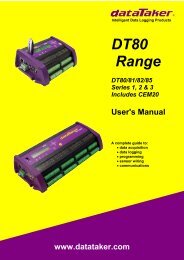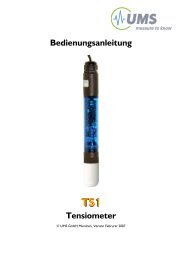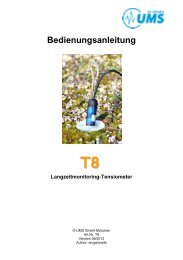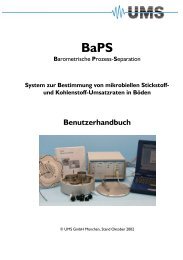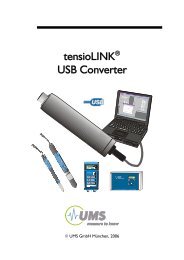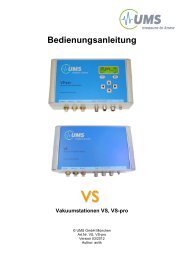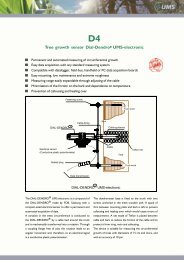T8 Manual - UMS
T8 Manual - UMS
T8 Manual - UMS
You also want an ePaper? Increase the reach of your titles
YUMPU automatically turns print PDFs into web optimized ePapers that Google loves.
Useful notes<br />
If there will be rain before the soils reaches -15 bars, the<br />
Tensiometer cup will suck up the soil water. However, the soil water<br />
includes dissolved gas which will degas as soon as a dry soil again<br />
will increase the tension. This will result in a poor response, the<br />
signal curve will get flatter and readings will only slowly adapt to the<br />
actual soil water tension. Depending on the size of the developed<br />
bubble readings will get less close to the maximum (fig. 7.2, after day<br />
20).<br />
Interpretation Interpretation Messwerte of readings unter below 10 bar 10 in bars tieferen<br />
Bodenschichten<br />
in a greater depth<br />
10000<br />
Soil water Wasserspannung<br />
tension (hPa)<br />
1000<br />
100<br />
10<br />
Soil Bodenwasserspannung<br />
water tension<br />
Tensiometermesswert reading<br />
1<br />
0 5 10 15 20 25 30 35<br />
Time Zeit<br />
Abb. 7.2 Tensiometer readings with tensions to -10 bars<br />
Other problems that can be recognized by checking the data:<br />
Soil water tension normally change only slowly. Therefore, a signal<br />
curve with lot of jumps could be an indicator for example for loose<br />
contacts, moisture in defective cables or plugs, poor power supply or<br />
data logger malfunction.<br />
With <strong>T8</strong> and T4e Tensiometers, unsteady signals might also be<br />
caused by solar radiation on the refilling tubes. This would require<br />
the use of thermal insulation - see chapter 3.1.4.<br />
45/56




